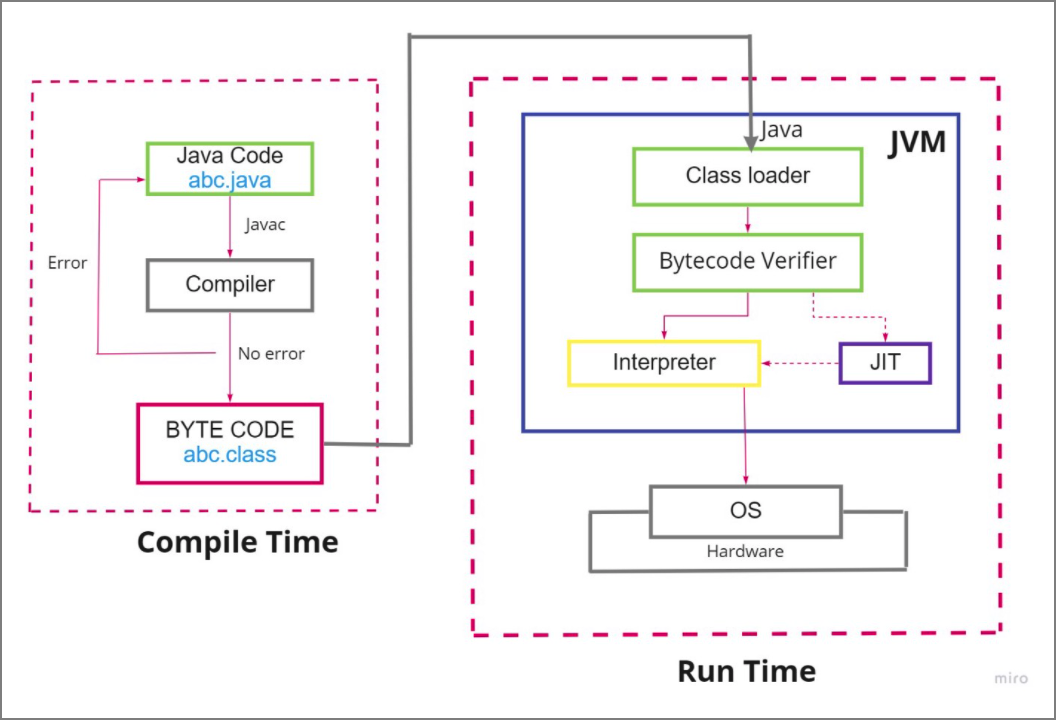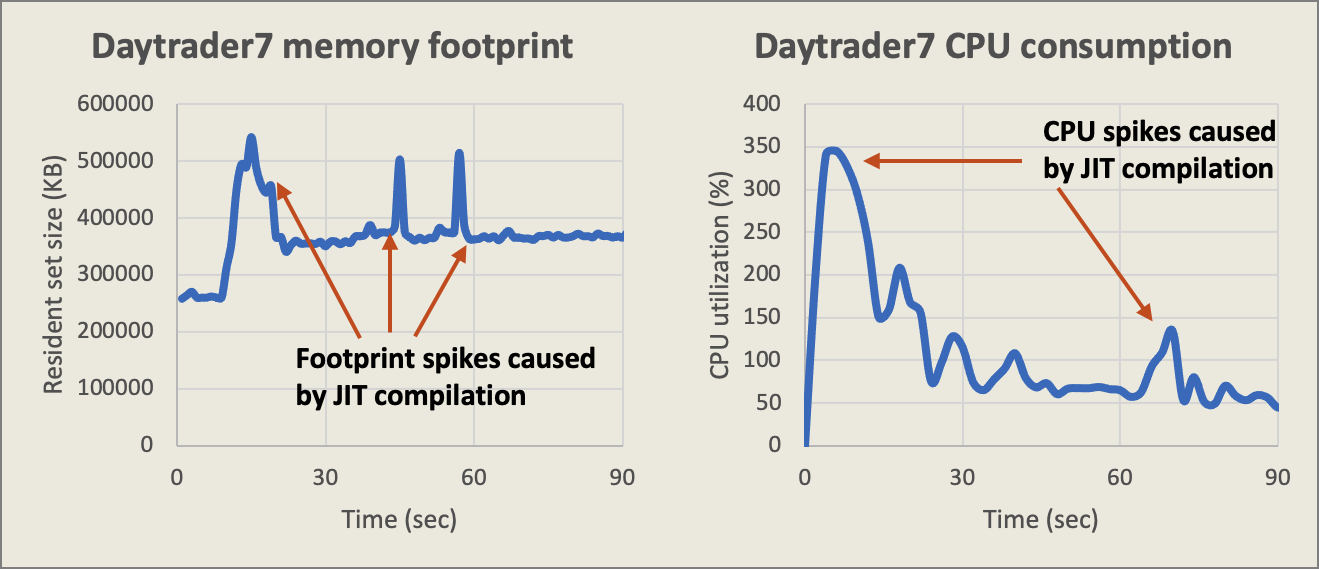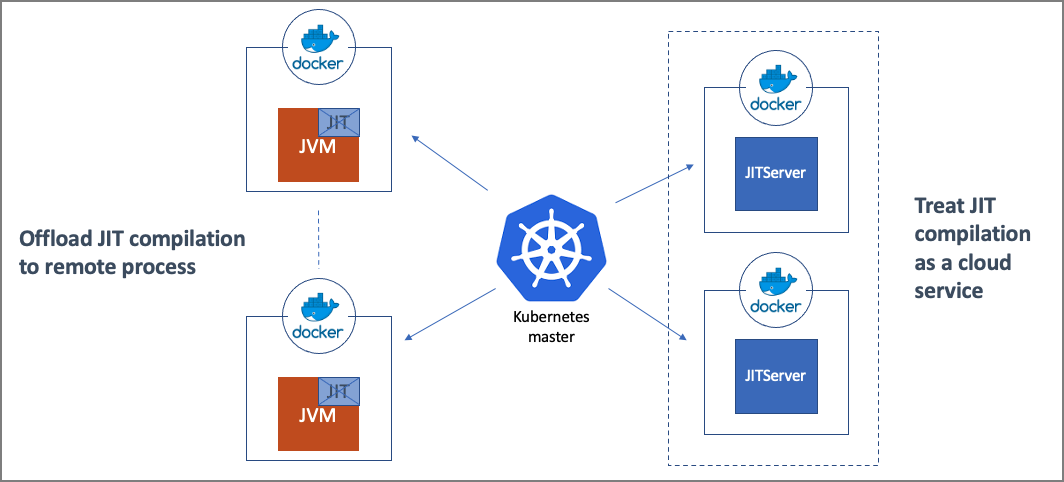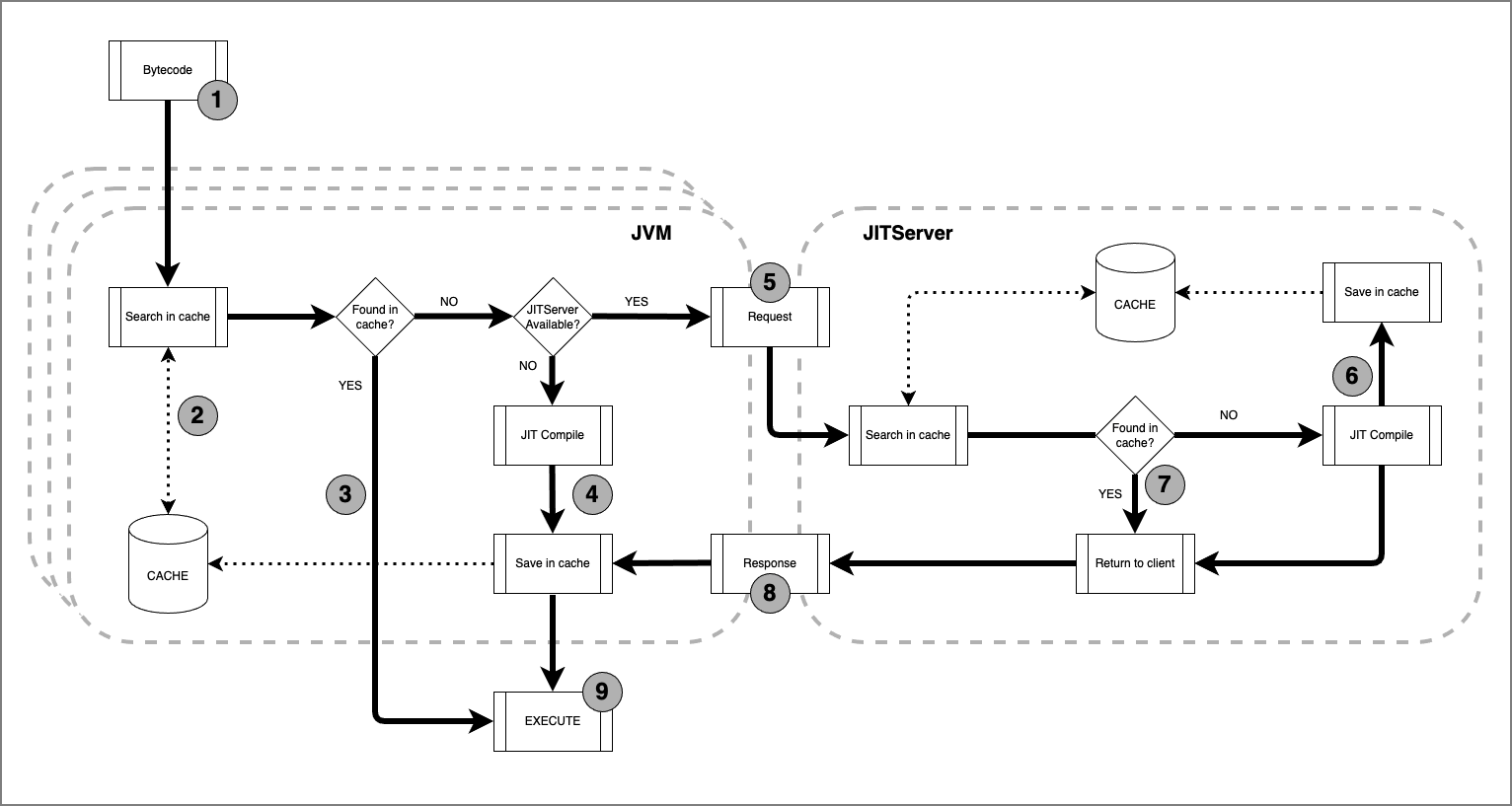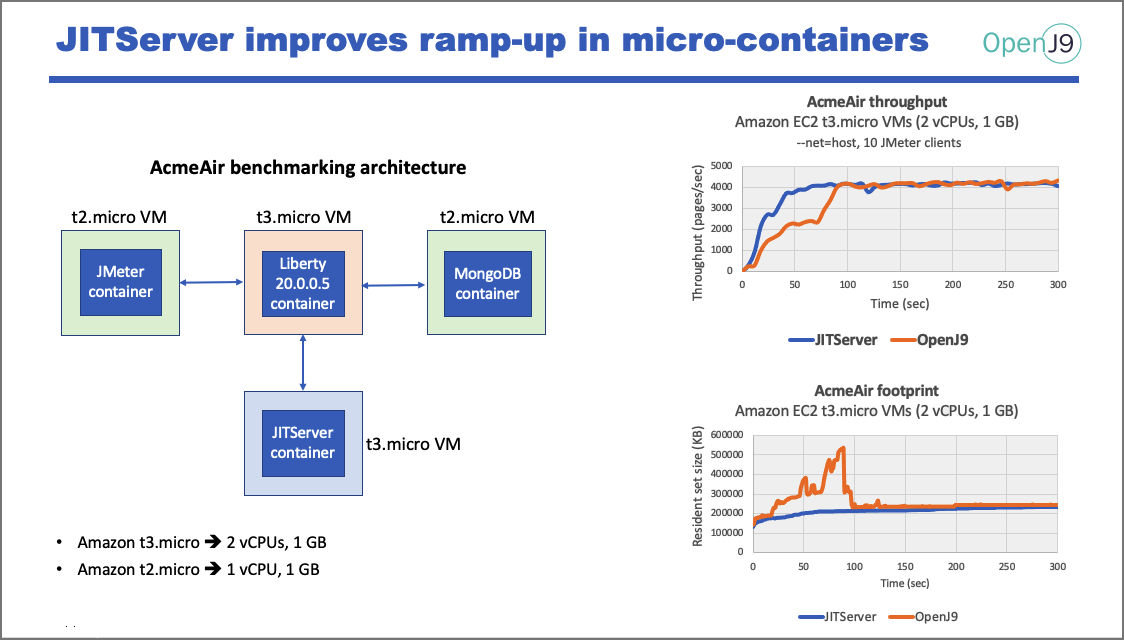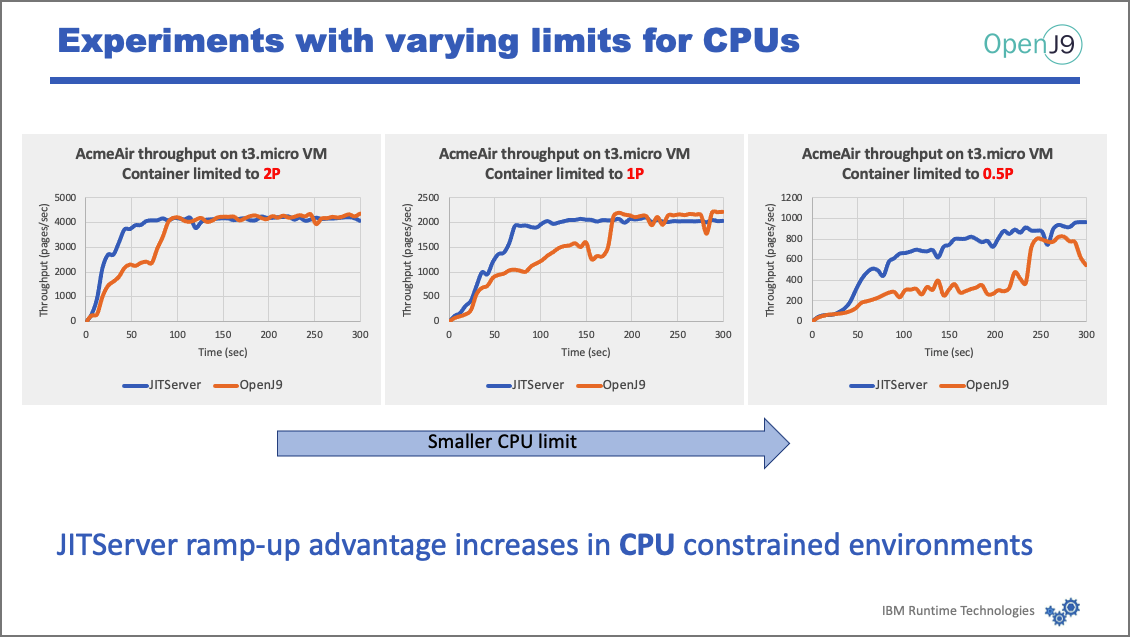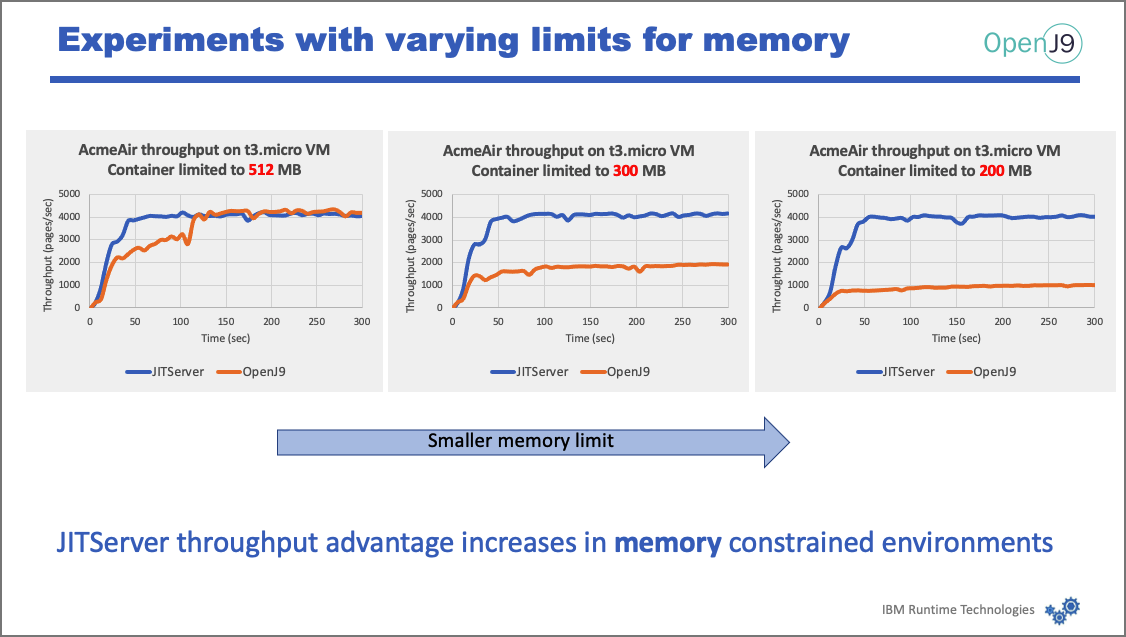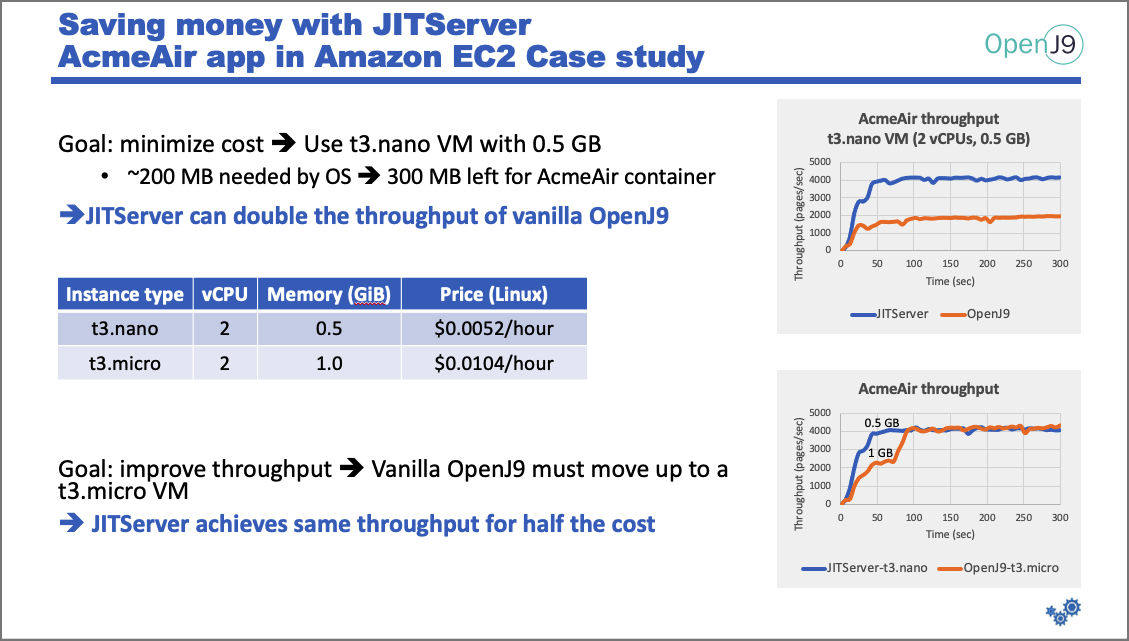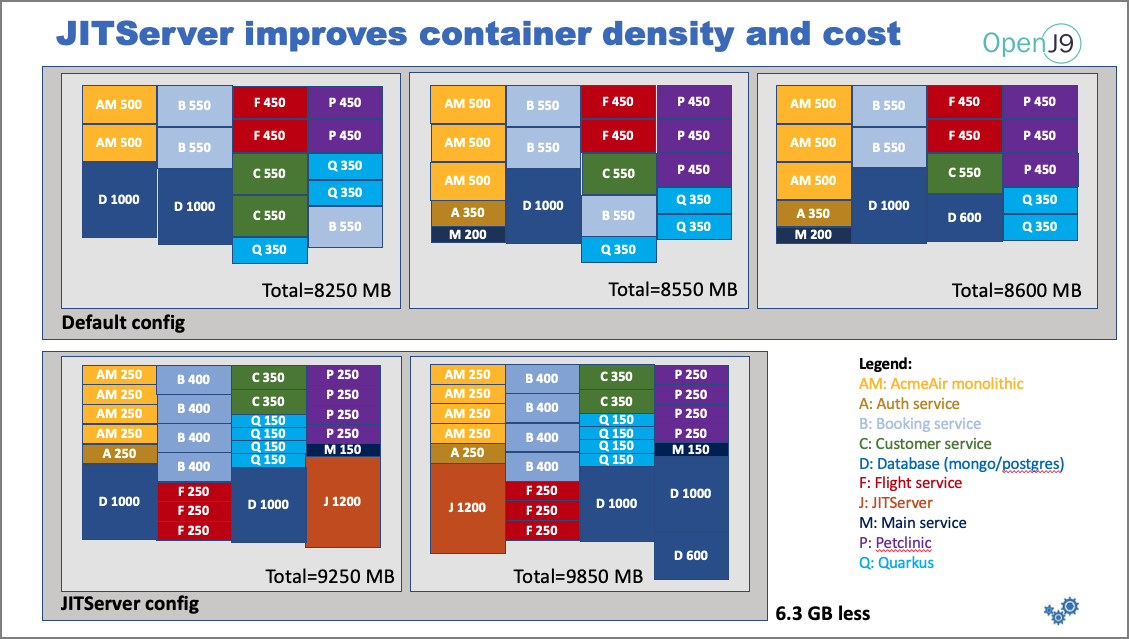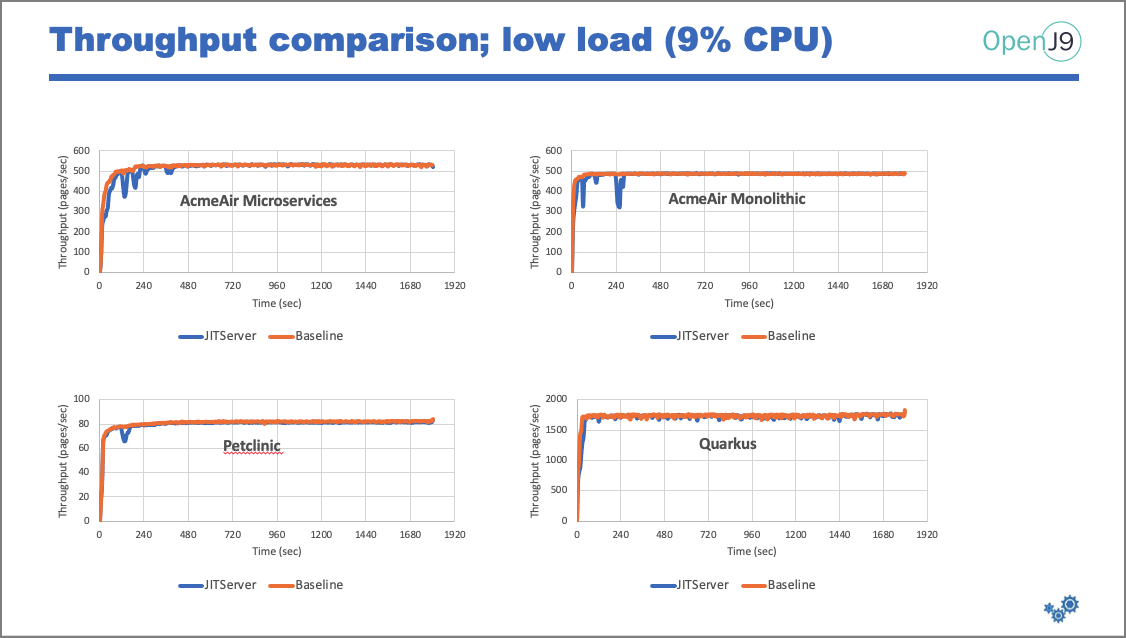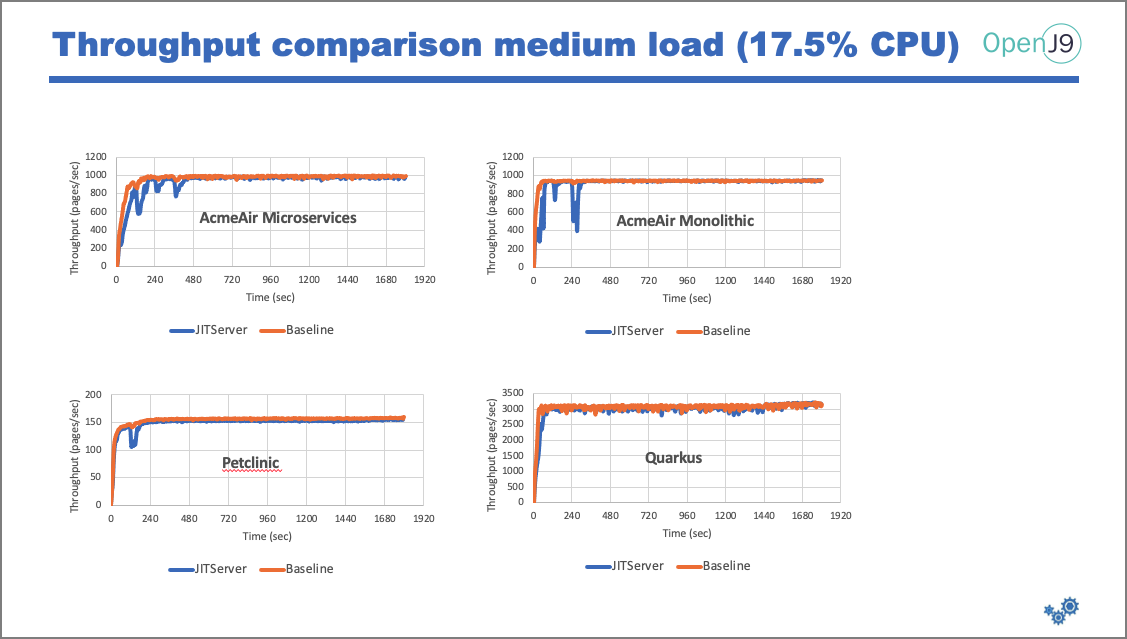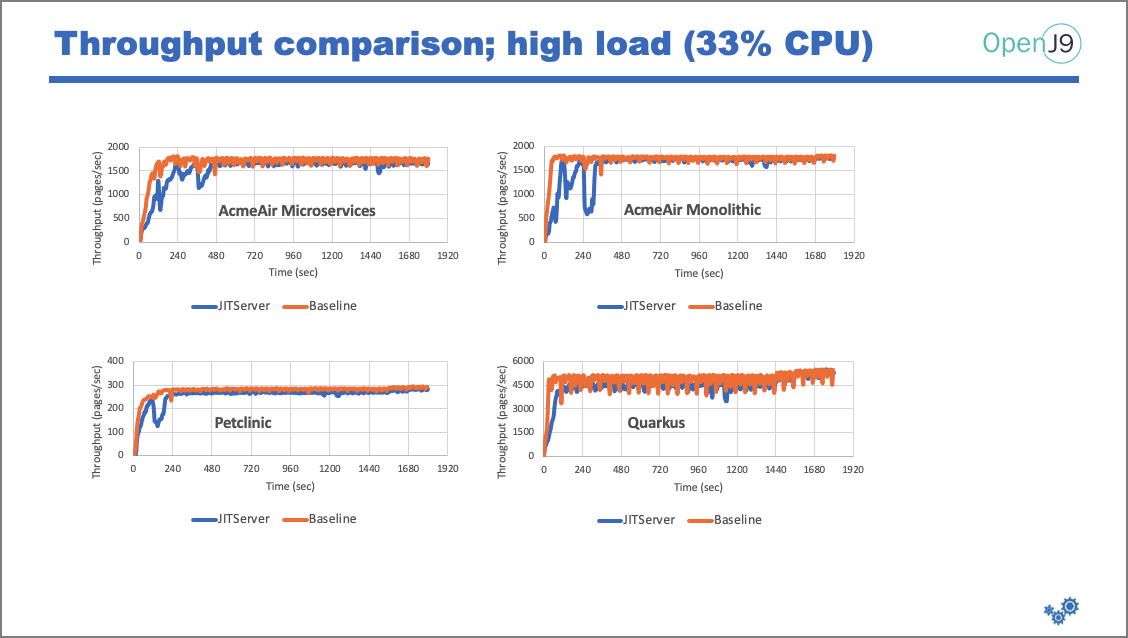With the current trend of migrating applications to the cloud, a new set of challenges have emerged - namely related to performance and cost. This article proposes that the OpenJ9 JITServer is a great solution to address both of these issues.
With the use of the JITServer (included with the Eclipse OpenJ9 JVM), we describe how it is possible to ensure the high Quality of Service (QoS) that clients demand, while also lowering costs through better use of managed container resources.
In this article we will cover JIT compiler basics, how the JITServer can make a big difference in a micro-container environment, and finally a working demo that utilizes the JITServer process.
- First came the JIT compiler
- JIT compilation - the good and the bad
- JITServer to the rescue
- JITServer vs vanilla JIT Compiler - how they stack up
- How JITServer can lower costs
- Best use cases for implementing JITServer
- Competing technologies
- Demo
- Where to get the JITServer
JIT compilers were first introduced to run Java code faster, making it more competitive with natively compiled platform-specific languages.
The theory behind the JIT compiler is to convert Java bytecode to machine code as the bytecode is interpreted line by line. Improvement gains are realized when the natively compiled version of that Java code is executed again.
The JIT compiler is a part of the Java Virtual Machine (JVM). Shown below is the workflow from Java code to execution on the host machine:
Compile Time - converting Java code to bytecode:
- javac abc.java - invokes the java compiler that converts the java code into bytecode.
- The bytecode is stored in a class file - abc.class
Run Time - execute the bytecode on the host machine:
- java abc - loads the class file bytecode into the class loader of the JVM.
- The bytecode verifier ensures the security of the bytecode.
- One line at a time, the interpreter converts the bytecode into machine code and executes it.
- The JIT compiler can improve execution performance by 10x over the interpreter. Based on profiling metrics, the JIT compiler will supply machine code of recurring bytecodes to the interpreter for execution.
The JIT compiler provides many positives when it comes to performance:
- Pre-compiled native machine code executes 10x faster than a line-by-line interpreter.
- The use of a code cache optimizes efficiency.
Unfortunately, the performance gains do not come without a cost, especially in a small container environment where a premium is placed on minimizing CPU and memory costs. Some of the negatives associated with JIT compilers include:
- Consumes more CPU cycles and memory.
- Slows application start-up.
- Can create memory spikes and/or OOM crashes.
- Spikes and crashes lower QoS.
- Added complexity of container provisioning due to factoring in worst-case scenarios.
- If JIT crashes, it takes down the whole JVM.
Here we show an example of how JIT compilation spikes effect CPU consumption and memory usage.
While this application may only use ~360MB of memory at steady state, the JIT compiler can create large footprint spikes. To avoid out of memory (OOM) induced crashes, the container will need to be sized to accommodate these occasional spikes. Additional experimental tests may need to be performed to determine how high the spikes can be.
Remember that in a container environment, native OOM events will result in the container being killed.
JITServer technology decouples the JIT compiler from the VM and lets the JIT compiler run remotely in its own process. This mechanism prevents your Java application suffering possible negative effects due to CPU and memory consumption caused by JIT compilation - if the JIT goes down, so does the the JVM and application.
With the JITServer, the application is not effected by the stability of the compilation - if the JITServer goes down, the application continues to run. The JVM retains the ability to compile locally using its local JIT compiler.
Here is an example architecture diagram of how the JITServer fits in a container environment:
Think of it as a micro-services solution applied at the JVM level. Here we split the JVM into multiple parts and communicate through the network. Kubernetes takes care of the scaling - more JITServer instances can be added or removed as needed.
This diagram shows a high-level view of the process flow between the JVM and the JITServer:
Note that in OpenJ9 the compilation occurs at the method level.
- The bytecode is passed into the JVM.
- The JVM checks if the method code is already stored in its local code cache.
- If the JVM already has the compiled method code, the code is executed.
- If the method needs to be compiled and no JITServer is running, the JVM JIT compiler is invoked. The compiled method code is then stored locally and then executed.
- If a JITServer is running, the method is passed to the JITServer where it will check if the code is already stored in its local code cache (this check is only performed if server side caching is enabled).
- If the JITServer does not have it stored locally, it will compile the method, store it in its local code cache, and then return the code back to the JVM.
- If the JITServer does have the method stored locally, it simply returns it to the JVM.
- The JVM receives the method code from the JITServer. The method code is then stored locally and then executed.
NOTE:
- The communication between the JVM and the JITServer typically involves multiple requests and responses. The JITServer may need additional info about the classes, profiling data, etc.
- Heuristics in the JVM are used to determine if the method should be compiled locally or sent to the JITServer. Some methods are very small (cheap compared to the local resources available) and are not worth sending over the network.
- Multiple JVMs can use the same JITServer. This is beneficial if/when multiple JVMs request the same method. If already stored in its cache, the JITServer will just return it. This takes less CPU resources and network latency is improved (no back and forth communication like normal - just one round-trip).
- From a developers perspective, the complexity of the JITServer is hidden.
Using a JITServer in a container environment provides multiple benefits:
- JIT compilation resources can be scaled independently from the Java aplication resources.
- Application containers can use smaller memory limits to minimize costs.
- Overall cluster memory utilization (JITServer included) is reduced, because memory consumption peaks from different applications don’t align.
- Provisioning is simpler - user only needs to care about application requirements.
- Ramp-up is faster, especially in constrained environments.
- Performance of short-lived applications is better.
- Performance is more predictable because CPU spikes caused by JIT compilation are eliminated.
- Autoscaling behavior is better (a direct consequence of faster ramp-up).
- Better cluster CPU utilization (including JITServer) when server side caching is used.
You may be wondering if the JITServer is compatible with another OpenJ9 feature - the Ahead-Of-Time (AOT) compiler.
The theory behind AOT is that during first-time execution, many Java methods are compiled and stored in the AOT shared class cache. Any additional JVMs that connect to the same shared class cache can take advantage of this AOT code.
With containers, AOT is not as useful. The shared class cache is embedded in the container, so when containers are destroyed, so is the shared class cache. Because of its potential short life-cycle, AOT is not a big advantage in a container environment. Conversely, the JITServer has a long life-cycle and can continue to provide benefits.
But, both features can be used together. In this case the AOT can help an application start and ramp-up faster. Once running, methods will still be sent to the JITServer, which is better able to optimize the code due to profile information derived from the running JVM. In general, JITServer compiled code is 10% more efficient than AOT compiled code.
These experiments were conducted on Amazon Elastic Compute Cloud (EC2) using micro VMs. They all compare the performance of using the JITServer vs non-JITServer standard OpenJ9 setup. As benchmark we used the AcmeAir JavaEE application, which runs on top of Open Liberty application server.
First we see how ramp-up time is improved using the JITServer (most compilations occur during ramp-up). We also see that there are no spikes in memory usage (memory consumption is flat and more predictable).
NOTE: ramp-up speed is more of an issue for short-lived applications. Behavior at beginning is very important.
Next we see the effects of limiting the number of processors, starting with 2, to 1, to .5. As the CPU limit decreases, the advantage of the JITServer solution becomes more pronounced (discrepancy increases between the 2). In other words, JITServer is more beneficial as you go into more and more CPU constrained environments.
In this last graph we see that the advantage of the JITServer increases as you go into more and more memory constrained environments.
To minimize cost using Amazon EC2, we will use the cheapest VMs available - the t3.nano and the t3.micro profiles. Both have 2 CPUs, but with different amounts of memory.
These graphs show how the profiles handle both a standard OpenJ9 setup and one which adds the JITServer.
The first graph shows that .5GB is not enough to run AcmeAir with OpenJ9 JVM. Roughly 200MB is needed by the OS, so only around 300MB is left for the JVM. As you can see, the performance of vanilla OpenJ9 is poor because 300 MB is not sufficient to run the Java application and perform the JIT compilations. OpenJ9 prefers to fail the JIT compilations (thus affecting performance) rather than risking a native OOM event. In contrast, when OpenJ9 offloads compilations to the JITServer the memory pressure drops and throughput increases significantly.
The second graph solves the low throughput problem by using a larger VM (the micro VM has double the memory, and double the price). The throughput is now equal, but it winds up costing you twice as much.
DISCLAIMER - these graphs do not show that an additional VM is required to run the JITServer, but that is only temporary. The JITServer can be taken down once the compilations have subsided.
In this next example, we show that utilizing the JITServer can lower the number of nodes required to support a set of applications (see this blog for more details).
This example consists of the following:
- Running on RedHat OpenShift Service on AWS (ROSA).
- The OpenShift Container Platform (OCP) consists of 3 master nodes, 2 infra nodes, and 3 worker nodes.
- The Worker nodes have 8 vCPUs and 16 GB RAM (only ~12.3 GB available to applications).
- Nodes will host 4 different applications:
- AcmeAir Microservices
- AcmeAir Monolithic
- Pet Clinic (Spring Boot framework)
- Quarkus
- A low amount of load was used to simulate real-world environments.
The top graph is using vanilla OpenJ9. Note that 3 nodes are required to hold all of the containers. Each box represents a container and lists the application and the memory requirements. The limits were determined by experiments to determine the minimum memory required to run without OOM issues. The boxes are scaled to indicate relative size.
The bottom graph has a JITServer configuration. Notice the size of boxes is much smaller which means less memory is required for each container. All the containers fit into 2 nodes, which saves 6.3GB of memory.
Since you pay by the node, using 33% less nodes means you save 33% in cost to manage this set of applications.
But just because you have want to maximize savings, you also need to provide the same throughput capabilities. Here we show how the applications perform under different CPU loads:
Peak throughput is the same in both configurations (with and without JITServer), which means we get the same amount of throughput but with less memory and less cost.
Key takeaways:
-
JITServer can improve container density and reduce operational costs of Java applications running in the cloud by 20-30%.
-
Ramp-up speed can be slightly affected in high density scenarios depending on the level of load and number of pods concurrently active - ie. noisy-neighbor effect occur when CPU resources are low and all applications want to compile at the same time (ramp-up), which rarely happens in reality.
There are trade-offs with using the JITServer. Here are the conditions where the JITServer provides the most value:
- Java application is required to compile many methods in a relatively short time.
- The application is running in a constrained environment with limited CPU or memory, which can no afford interference from the local JIT compiler.
- The network latency between JITServer and client VM is relatively low (<1ms).
How the JITServer should be implemented:
- 10-20 client JVMs connected to a single JITServer instance.
- Two smaller JITServer instances are better than a single bigger one.
- JITServer needs 1-2 GB of RAM.
- Use vCPU “limits” much larger than “requests” to allow for CPU usage spikes.
- Better performance if the compilation phases from different JVM clients do not overlap (stagger).
Currently, the only other product with a functionality somewhat similar to OpenJ9 JITServer is the Cloud Native Compiler (CNC) from Azul. In contrast to OpenJ9 JITserver, CNC is a payed offering, uses proprietary code and requires a non-disclosure license to use.
Click here to check out a demo where we show how to configure and run multiple containers with a JITServer. We will also use Grafana to graph CPU and memory metrics showing how the JITServer can better utilize and minimize system resources.
As mentioned previously, the JITServer comes with the standard Eclipse OpenJ9 JVM. In fact, the JITServer is actually just another instance of the OpenJ9 JVM, but with a different persona.
The OpenJ9 JVM is open-source and free to download. Due to licensing issues, the only vendor that currently provides install packages and support is IBM, via the Semeru Runtimes.
IBM Semeru Runtimes is IBM's supported open source version of the Java SDK, and fully implements the Oracle Java Standard Edition (SE) APIs.
For downloads, visit the IBM Developer site.
